The floods got me thinking again about one of our former local celebrities, whose second book (and the first that he later acknowledged) ‘The Drowned World‘, published in 1962 was set in a post-apocalyptic and largely unrecognisable London of 2145, mostly underwater and tropical thanks to the effects of global warming. Back in the 1960s it seemed far-fetched, though now it seems only too likely.
On one sunny afternoon in January as the Thames was beginning to subside, I got on my bike and took a ride, camera around my neck and decided to make a short pilgrimage to the street where he had lived for many years.
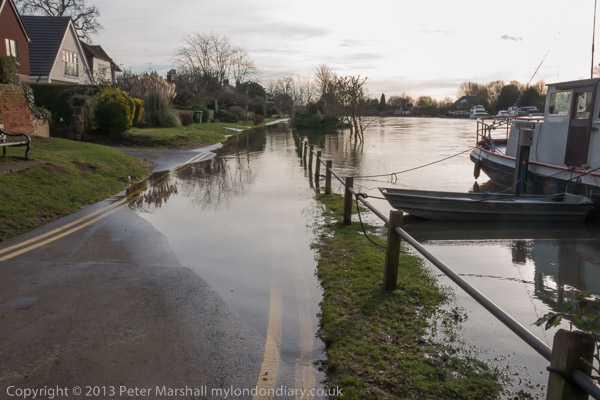
It got deeper further on and I turned down a side road away from the river
I wasn’t in a hurry and decided to try the scenic route, along by the riverside most of the way, though I was fairly sure that the road by the Thames would still be closed and I would have to divert – and this turned out to be so. I could perhaps have pushed on a little further through the flooded tow-path at Laleham, but I would have risked getting my feet (and perhaps more) wet if I had to stop or met an underwater pothole.
Its a rather boring but shorter ride on the main road through Shepperton Green to Shepperton, ending with a little climb on the bridge over the motorway, and then down with the traffic lights at the bottom of the hill almost always wasting your momentum, and cars getting in the way in a queue for them.
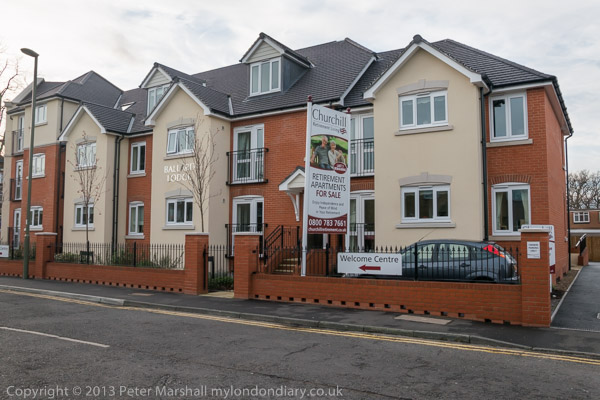
I’m not aware of any blue plaque or other official recognition of J G Ballard in the area, certainly there is nothing on the actual semi-detached house where he lived and which was sold following his death in 2009. But as I moved off from the lights I saw the new and rather ugly new block on the corner, Ballard Lodge retirement apartments. It would perhaps have amused him slightly, perhaps in a true Ballardian fashion.
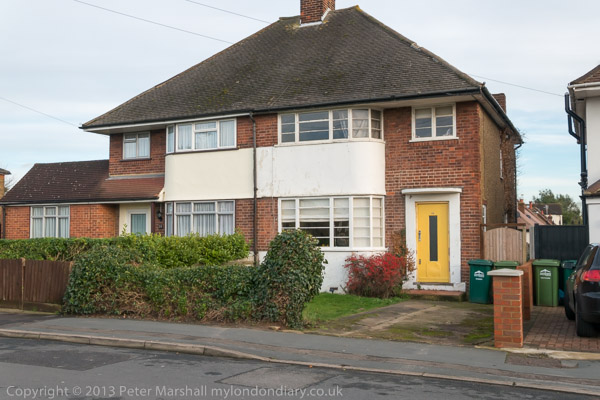
I don’t think his house has changed much. Still the 1930s windows and the faintly ridiculous door surround and a dowdy patch of lawn. But I didn’t like to stop and stare too long at what is just an ordinary semi.
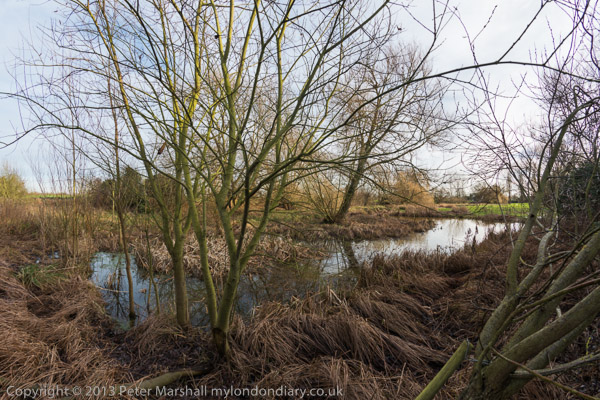
The road now ends short of where it did when he moved there in 1960, but there was still an area of swampy ground where perhaps he sometimes walked and perhaps thought about his work. The River Ash runs just to one side, quite a small stream, bring water from the Colne at the southern edge of Staines Moor and flowing on into the Thames.
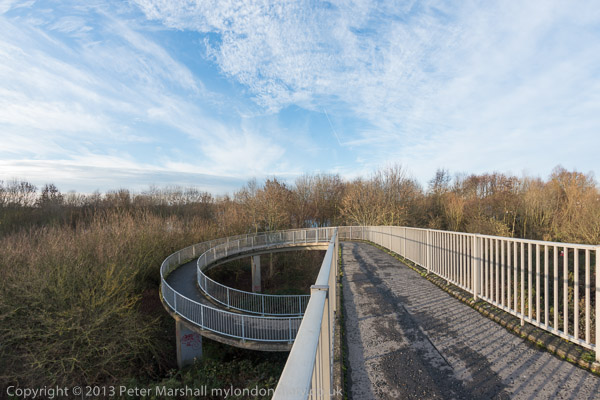
Behind me when I made this picture was the spiral ramp up which he may have sometimes walked, built as the M3 cut across his road, and I pushed my bike up it wondering if he had contemplated the building of the motorway when writing perhaps his best-known work, ‘Crash’. Unlike the film version, much of the book was set in this south-west area of Middlesex, along with some of his other works.
You can see a few more of my images from the area on Shepperton & Ballard, where I also have written a little more about the man who has been described as our most important post-war novelist. Perhaps not, but certainly one worth reading, and one who had some influence on my own project ‘Under the Car’ back in the 1970s.

You can read a little more about that in Under the Car, posted on this site in 2007, based on part of a presentation I gave in Brasilia.
The ‘The Drowned World‘ is one of a number of Ballard’s novels s that is still available. You can read (and download) the book online.
The pictures from Laleham and Shepperton were taken on the Nikon D800E with either the 18-105mm DX or 16mm Nikon FX fisheye (and with a little help from the Fisheye-Hemi plugin.) The D800E gets a little heavy around the neck when cycling, even though both of the lenses are fairly small and light. The one not on the camera fitted in a jacket pocket.
I’m getting to like the 16mm a lot, perhaps even a better lens than the 10.5mm DX, certainly less chromatic aberration, though Lightroom does a good job of removing that in any case. It’s possibly the only FX lens that is smaller and lighter than its DX equivalent, though there is much in it. It works well on both the D700 and D800E, though I’m more likely to use it on the D700 for most things simply because of the huge files it produces on the D800E. The 32Mp raw files are a not unreasonable 32Mb or so, but to use Fisheye-Hemi, Lightroom has to export a 16 bit Tiff file, and these are around 200Mb a time. With the D700 they are a more reasonable 65Mb or so.
But by the time I got home, even though I’d probably only cycled around ten miles I was beginning to wonder why I hadn’t picked up the Fuji X-Pro1 instead as my neck was beginning to ache. With the 18-55 Fuji X and the 8mm Samyang fisheye the load would have been lighter.
______________________________________________________
My London Diary : Buildings of London : River Lea/Lee Valley : London’s Industrial Heritage
All photographs on this and my other sites, unless otherwise stated, are taken by and copyright of Peter Marshall, and are available for reproduction or can be bought as prints.
To order prints or reproduce images
________________________________________________________